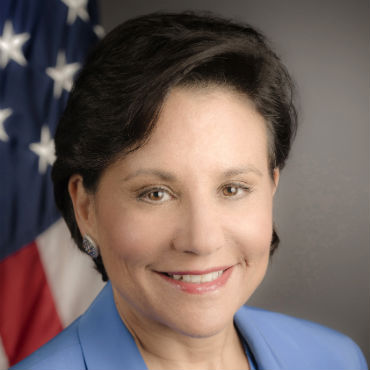What Pritzker wants from Silicon Valley

In first official visit to the West Coast tech mecca, Commerce secretary solicits partnerships on climate data and highlights new Census tool.

Commerce Secretary Penny Pritzker is on her first tour of Silicon Valley since joining the Obama administration in June 2013.
SUNNYVALE, Calif. – Commerce Secretary Penny Pritzker on Feb. 24 asked Silicon Valley’s business community for ideas on how the administration can best unlock the commercial potential of its gargantuan troves of climate and environmental data – at no cost to the federal taxpayer.
“Each day, NOAA [the National Oceanic and Atmospheric Administration] collects and produces 20 terabytes of environmental data, from weather forecasts to climate change, to ocean currents,” Pritzker noted in a speech delivered in Sunnyvale at “Plug and Play,” a local startup accelerator. “This is twice the data of the entire printed collection of the entire Library of Congress, yet only a small percentage of that information – roughly two terabytes – is made easily accessible to the public.”
Pritzker’s comments were made in the context of a listening tour -- this is her first visit to Silicon Valley as Commerce Secretary. Later in the week, she will meet with executives at Google, Facebook and eBay, among others.
NOAA is one of the 12 agencies that fall under the umbrella of the Department of Commerce. The agency on Friday issued a request for information that solicits detailed ideas from the private sector on how companies and other kinds of organizations could host NOAA’s output in a standardized, usable format in the cloud, in a form that could be made widely accessible to the public. NOAA says in its RFI that this must happen at no cost to the federal government.
“NOAA anticipates these partnerships will have the ability to rapidly scale and surge; thus removing government infrastructure as a bottleneck to the pace of American innovation and enabling new value-added services and unimaginable integration into our daily lives,” says the text of NOAA’s RFI.
The problem with the current data structure at NOAA, according to the RFI, is that the information sits on various Web servers in no particular standardized format, making it difficult to parse and analyze on a large scale.
It’s expected that new companies making use of this information will spur economic growth. Pritzker noted that “weather and climate-sensitive industries account for roughly one third of the GDP.”
Pritzker also announced that the Census Bureau is adding technology workforce and payroll data to its Census Explorer mapping system.
“Today, we’re adding tech workforce and payroll data into those maps so that entrepreneurs and business leaders like you can see where tech workers are geographically concentrated,” she said. “You’ll now be able to look at tech employment in regions along with other factors like education, labor force participation and home ownership rates, so check it out.”
The Commerce secretary, an entrepreneur herself, knows the value of government data. Twenty-five years ago, she started building a residence business catering to seniors. In press interviews, she said that she relied on census data to figure out where she should locate the business.
NEXT STORY: What CIOs say about big data


